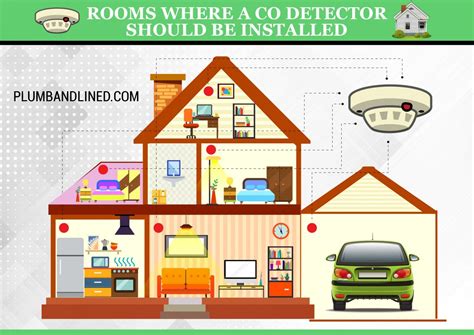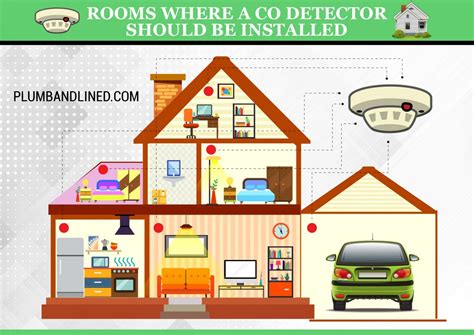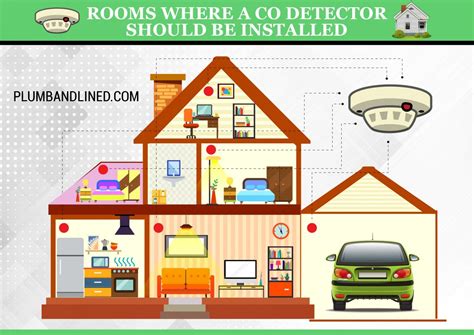Carbon monoxide (CO) is a colorless, odorless, and tasteless gas that can be deadly in high concentrations. It is produced by burning any type of fuel, such as gasoline, natural gas, propane, wood, or charcoal. According to the Centers for Disease Control and Prevention (CDC), more than 400 Americans die each year from unintentional CO poisoning, and over 20,000 visit the emergency room. To protect against CO poisoning, it is crucial to install carbon monoxide detectors in the home and ensure they are placed correctly. In this article, we will discuss where carbon monoxide detectors should be placed to provide optimal protection.
Key Points
- Carbon monoxide detectors should be placed on every level of the home, including the basement and attic.
- Detectors should be installed within 10 feet of sleeping areas to ensure occupants are alerted in case of a CO leak during sleep.
- Place detectors near fuel-burning appliances, such as furnaces, water heaters, and generators, to detect potential CO leaks.
- Avoid placing detectors near windows, doors, or vents, as drafts can interfere with their accuracy.
- Follow the manufacturer's instructions for installation and maintenance to ensure the detectors function correctly.
Understanding Carbon Monoxide Detectors

Carbon monoxide detectors are designed to detect the presence of CO in the air and alert occupants with a loud alarm. They can be battery-powered or hardwired, and some models come with additional features, such as digital displays and voice alerts. When selecting a CO detector, look for one that meets the standards of Underwriters Laboratories (UL) or the International Association of Fire Fighters (IAFF). It is essential to understand that CO detectors are not substitutes for regular maintenance of fuel-burning appliances and venting systems.
Placement Guidelines
To ensure effective detection of CO, detectors should be placed in the following locations:
- Every level of the home: Install detectors on each floor, including the basement and attic, to provide comprehensive coverage.
- Near sleeping areas: Place detectors within 10 feet of sleeping areas to alert occupants in case of a CO leak during sleep.
- Near fuel-burning appliances: Install detectors near furnaces, water heaters, generators, and other fuel-burning appliances to detect potential CO leaks.
- Avoiding interference: Do not place detectors near windows, doors, or vents, as drafts can interfere with their accuracy.
| Location | Recommended Distance |
|---|---|
| Near sleeping areas | Within 10 feet |
| Near fuel-burning appliances | Within 10 feet |
| Away from windows and doors | At least 5 feet |

Additional Considerations

When installing CO detectors, consider the following factors:
- Power source: Choose detectors that are either battery-powered or hardwired, depending on your preference and the electrical configuration of your home.
- Interconnected systems: Consider installing interconnected CO detectors, which can alert occupants throughout the home in case of a CO leak.
- Maintenance and testing: Regularly test and maintain CO detectors to ensure they are functioning correctly.
Regulations and Standards
Various regulations and standards govern the installation and maintenance of CO detectors. For example, the National Fire Protection Association (NFPA) recommends installing CO detectors on every level of the home, including the basement and attic. Additionally, many states and local jurisdictions have laws and regulations regarding CO detector installation and maintenance. It is essential to familiarize yourself with the specific regulations in your area and follow the manufacturer’s instructions for installation and maintenance.
What is the recommended distance for placing CO detectors near sleeping areas?
+The recommended distance for placing CO detectors near sleeping areas is within 10 feet.
Can I place CO detectors near windows or doors?
+No, it is not recommended to place CO detectors near windows or doors, as drafts can interfere with their accuracy.
How often should I test my CO detectors?
+CO detectors should be tested monthly, and batteries should be replaced according to the manufacturer's instructions.
In conclusion, proper placement of carbon monoxide detectors is crucial to protecting against CO poisoning. By following the guidelines outlined in this article and adhering to local regulations and manufacturer instructions, you can ensure the effective detection of CO in your home and help prevent unnecessary deaths and injuries. Remember to always prioritize the safety and well-being of your family and loved ones by taking proactive steps to prevent CO poisoning.



